Minimizing the Fluoride Load in Water Using the Electrocoagulation Method: An Experimental Approach
Abstract
:1. Introduction
2. Materials and Methods
2.1. Chemicals and Solution
2.2. New EC Reactor
2.3. Experiments
2.4. Operating Cost
3. Results and Discussion
3.1. Effects of CD on F- Removal
3.2. Effects of pHoS on F- Removal
3.3. Effects of ELD on F- Removal
3.4. Effects of IFC on F- Removal
3.5. Power Consumption and Operating Cost
4. Conclusions
- The new EC reactor can remediate water from F-, with an efficiency of 98.3%.
- The new design of the reactor and the electrodes reduce the need for external water mixers, which in turn minimizes the power consumption.
- The removal of F- by the EC increases with the applied CD but decreases with the increase of pHoS, ELD, and IFC.
- The calculated operating cost of the new EC reactor was slightly cheaper in comparison with the traditional electrocoagulation reactor.
Author Contributions
Funding
Institutional Review Board Statement
Informed Consent Statement
Conflicts of Interest
References
- Arif, M.; Hussain, J.; Hussain, I.; Kumar, S. An Assessment of Fluoride Concentration in Groundwater and Risk on Health of North Part of Nagaur District, Rajasthan, India. World Appl. Sci. J. 2013, 24, 146–153. [Google Scholar] [CrossRef]
- Hashim, K.S.; Shaw, A.; Al Khaddar, R.; Ortoneda Pedrola, M.; Phipps, D. Defluoridation of drinking water using a new flow column-electrocoagulation reactor (FCER)—Experimental, statistical, and economic approach. J. Environ. Manag. 2017, 197, 80–88. [Google Scholar] [CrossRef] [PubMed]
- Sandoval, M.A.; Fuentes, R.; Nava, J.L.; Coreño, O.; Li, Y.; Hernández, J.H. Simultaneous removal of fluoride and arsenic from groundwater by electrocoagulation using a filter-press flow reactor with a three-cell stack. Sep. Purif. Technol. 2019, 208, 208–216. [Google Scholar] [CrossRef]
- Al-Marri, S.; AlQuzweeni, S.S.; Hashim, K.S.; Al Khaddar, R.; Kot, P.; Al Kizwini, R.S.; Zubaidi, S.L.; Al-Khafaji, Z.S. Ultrasonic-Electrocoagulation method for nitrate removal from water. In IOP Conference Series: Materials Science and Engineering, Proceedings of the 2nd International Conference on Civil and Environmental Engineering Technologies (ICCEET 2020) Kufa, Najaf, Iraq, 10–11 June 2020; IOP Publishing: Bristol, UK, 2020; Volume 888, p. 012073. [Google Scholar] [CrossRef]
- Castaneda, L.F.; Rodriguez, J.F.; Nava, J.L. Electrocoagulation as an affordable technology for decontamination of drinking water containing fluoride: A critical review. Chem. Eng. J. 2021, 413, 127529. [Google Scholar] [CrossRef]
- Halpegama, J.; Heenkenda, K.; Wu, Z.; Nanayakkara, K.; Rajapakse, R.; Bandara, A.; Herath, A.C.; Chen, X.; Weerasooriya, R. Concurrent removal of hardness and fluoride in water by monopolar electrocoagulation. J. Environ. Chem. Eng. 2021, 9, 106105. [Google Scholar] [CrossRef]
- Aoudj, S.; Khelifa, A.; Drouiche, N.; Belkada, R.; Miroud, D. Simultaneous removal of chromium (VI) and fluoride by electrocoagulation–electroflotation: Application of a hybrid Fe-Al anode. Chem. Eng. J. 2015, 267, 153–162. [Google Scholar] [CrossRef]
- Aoudj, S.; Khelifa, A.; Drouiche, N. Removal of fluoride, SDS, ammonia and turbidity from semiconductor wastewater by combined electrocoagulation–electroflotation. Chemosphere 2017, 180, 379–387. [Google Scholar] [CrossRef]
- Grich, N.B.; Attour, A.; Mostefa, M.L.P.; Guesmi, S.; Tlili, M.; Lapicque, F. Fluoride removal from water by electrocoagulation: Effect of the type of water and the experimental parameters. Electrochim. Acta 2019, 316, 257–265. [Google Scholar] [CrossRef]
- Zubaidi, S.; Ortega-Martorell, S.; Al-Bugharbee, H.; Olier, I.; Hashim, K.S.; Gharghan, S.K.; Kot, P.; Al-Khaddar, R. Urban Water Demand Prediction for a City that Suffers from Climate Change and Population Growth: Gauteng Province case study. Water 2020, 12, 1885. [Google Scholar] [CrossRef]
- Hashim, K.S.; Shaw, A.; Al Khaddar, R.; Kot, P.; Al-Shamma’a, A. Water purification from metal ions in the presence of organic matter using electromagnetic radiation-assisted treatment. J. Clean. Prod. 2021, 280, 124427. [Google Scholar] [CrossRef]
- Alhendal, M.; Nasir, M.J.; Hashim, K.S.; Amoako-Attah, J.; Al-Faluji, D.; Muradov, M.; Kot, P.; Abdulhadi, B. Cost-effective hybrid filter for remediation of water from fluoride. In IOP Conference Series: Materials Science and Engineering, Proceedings of the 2nd International Conference on Civil and Environmental Engineering Technologies (ICCEET 2020) Kufa, Najaf, Iraq, 10–11 June 2020; IOP Publishing: Bristol, UK, 2020; Volume 888, p. 012038. [Google Scholar] [CrossRef]
- Un, U.T.; Koparal, A.S.; Bakir Ogutveren, U. Fluoride removal from water and wastewater with a bach cylindrical electrode using electrocoagulation. Chem. Eng. J. 2013, 223, 110–115. [Google Scholar] [CrossRef]
- Garg, U.K.; Sharma, C. Electrocoagulation: Promising technology for removal of fluoride from drinking water—A review. Biol. Forum-Int. J. 2016, 8, 248–254. [Google Scholar]
- Abdulhadi, B.; Kot, P.; Hashim, K.; Shaw, A.; Muradov, M.; Al Khaddar, R. Continuous-flow electrocoagulation (EC) process for iron removal from water: Experimental, statistical and economic study. Sci. Total Environ. 2021, 760, 143417. [Google Scholar] [CrossRef]
- Guo, W.; Ngo, H.-H.; Li, J. A mini-review on membrane fouling. Bioresour. Technol. 2012, 122, 27–34. [Google Scholar] [CrossRef] [PubMed]
- Teixeira, M.R.; Nunes, L.M. The impact of natural organic matter seasonal variations in drinking water quality. Desalination Water Treat. 2011, 36, 344–353. [Google Scholar] [CrossRef]
- Jadhav, S.V.; Bringas, E.; Yadav, G.D.; Rathod, V.K.; Ortiz, I.; Marathe, K.V. Arsenic and fluoride contaminated groundwaters: A review of current technologies for contaminants removal. J. Environ. Manag. 2015, 162, 306–325. [Google Scholar] [CrossRef]
- Singh, J.; Singh, P.; Singh, A. Fluoride ions vs. removal technologies: A study. Arab. J. Chem. 2016, 9, 815–824. [Google Scholar] [CrossRef]
- Hashim, K.; Kot, P.; Zubaid, S.; Alwash, R.; Al Khaddar, R.; Shaw, A.; Al-Jumeily, D.; Aljefery, M. Energy efficient electrocoagulation using baffle-plates electrodes for efficient Escherichia coli removal from wastewater. J. Water Process Eng. 2020, 33, 101079–101086. [Google Scholar] [CrossRef]
- Hashim, K.S.; Ali, S.S.M.; AlRifaie, J.K.; Kot, P.; Shaw, A.; Al Khaddar, R.; Idowu, I.; Gkantou, M. Escherichia coli inactivation using a hybrid ultrasonic–electrocoagulation reactor. Chemosphere 2020, 247, 125868–125875. [Google Scholar] [CrossRef] [PubMed]
- Ouaissa, Y.A.; Chabani, M.; Amrane, A.; Bensmaili, A. Removal of Cr(VI) from Model Solutions by a Combined Electrocoagulation Sorption Process. Chem. Eng. Technol. 2013, 36, 147–155. [Google Scholar] [CrossRef]
- Naje, A.S.; Chelliapan, S.; Zakaria, Z.; Abbas, S.A. Electrocoagulation using a rotated anode: A novel reactor design for textile wastewater treatment. J. Environ. Manag. 2016, 176, 34–44. [Google Scholar] [CrossRef]
- Castro-Rios, K.; Taborda-Ocampo, G.; Torres-Palma, R.A. Experimental Design to Measure Escherichia coli Removal in Water Through Electrocoagulation. Int. J. Electrochem. Sci. 2014, 9, 610–617. [Google Scholar]
- Kumari, S.; Kumar, R.N. River water treatment using electrocoagulation for removal of acetaminophen and natural organic matter. Chemosphere 2021, 273, 128571. [Google Scholar] [CrossRef]
- Bian, Y.; Ge, Z.; Albano, C.; Lobo, F.L.; Ren, Z.J. Oily bilge water treatment using DC/AC powered electrocoagulation. Environ. Sci. Water Res. Technol. 2019, 5, 1654–1660. [Google Scholar] [CrossRef]
- Xu, J.; Du, X.; Zhao, W.; Wang, Z.; Lu, X.; Zhu, L.; Wang, Z.; Liang, H. Roofing rainwater cleaner production using pilot-scale electrocoagulation coupled with a gravity-driven membrane bioreactor (EC-GDMBR): Water treatment and energy efficiency. J. Clean. Prod. 2021, 314, 128055. [Google Scholar] [CrossRef]
- Tian, Y.; He, W.; Liang, D.; Yang, W.; Logan, B.E.; Ren, N. Effective phosphate removal for advanced water treatment using low energy, migration electric–field assisted electrocoagulation. Water Res. 2018, 138, 129–136. [Google Scholar] [CrossRef] [PubMed]
- Islam, S. Electrocoagulation (EC) technology for wastewater treatment and pollutants removal. Sustain. Water Resour. Manag. 2019, 5, 359–380. [Google Scholar] [CrossRef]
- Wan, W.; Pepping, T.J.; Banerji, T.; Chaudhari, S.; Giammar, D.E. Effects of water chemistry on arsenic removal from drinking water by electrocoagulation. Water Res. 2011, 45, 384–392. [Google Scholar] [CrossRef] [PubMed]
- Kuokkanen, V. Utilization of Electrocoagulation for Water and Wastewater Treatment and Nutrient Recovery. Techno-Economic Studies. Ph.D. Thesis, University of Oulu Graduate School, University of Oulu, Oulu, Finland, 2016. [Google Scholar]
- Hashim, K.S.; Khaddar, R.A.; Jasim, N.; Shaw, A.; Phipps, D.; Kot, P.; Pedrola, M.O.; Alattabi, A.W.; Abdulredha, M.; Alawsh, R. Electrocoagulation as a green technology for phosphate removal from river water. Sep. Purif. Technol. 2019, 210, 135–144. [Google Scholar] [CrossRef]
- Tchamango, S.R.; Darchen, A. Investigation and optimization of a new electrocoagulation reactor with horizontal bipolar electrodes: Effect of electrode structure on the reactor performances. J. Environ. Chem. Eng. 2018, 6, 4546–4554. [Google Scholar] [CrossRef]
- Essadki, A.H.; Gourich, B.; Vial, C.; Delmas, H.; Bennajah, M. Defluoridation of drinking water by electrocoagulation/electroflotation in a stirred tank reactor with a comparative performance to an external-loop airlift reactor. J. Hazard. Mater. 2009, 168, 1325–1333. [Google Scholar] [CrossRef] [Green Version]
- Mena, V.; Betancor-Abreu, A.; González, S.; Delgado, S.; Souto, R.; Santana, J. Fluoride removal from natural volcanic underground water by an electrocoagulation process: Parametric and cost evaluations. J. Environ. Manag. 2019, 246, 472–483. [Google Scholar] [CrossRef]
- López-Guzmán, M.; Alarcón-Herrera, M.; Irigoyen-Campuzano, J.; Torres-Castañón, L.; Reynoso-Cuevas, L. Simultaneous removal of fluoride and arsenic from well water by electrocoagulation. Sci. Total Environ. 2019, 678, 181–187. [Google Scholar] [CrossRef]
- Sandoval, M.A.; Fuentes, R.; Thiam, A.; Salazar, R. Arsenic and fluoride removal by electrocoagulation process: A general review. Sci. Total. Environ. 2021, 753, 142108. [Google Scholar] [CrossRef]
- Alimohammadi, M.; Mesdaghinia, A.; Shayesteh, M.; Mansoorian, H.; Khanjani, N. The efficiency of the electrocoagulation process in reducing fluoride: Application of inductive alternating current and polarity inverter. Int. J. Environ. Sci. Technol. 2019, 16, 8239–8254. [Google Scholar] [CrossRef]
- Palahouane, B.; Drouiche, N.; Aoudj, S.; Bensadok, K. Cost-effective electrocoagulation process for the remediation of fluoride from pretreated photovoltaic wastewater. J. Ind. Eng. Chem. 2015, 22, 127–131. [Google Scholar] [CrossRef]
- Ezechi, E.H.; Isa, M.H.; Muda, K.; Kutty, S.R.M. A comparative evaluation of two electrode systems on continuous electrocoagulation of boron from produced water and mass transfer resistance. J. Water Process Eng. 2020, 34, 101133. [Google Scholar] [CrossRef]
- Nasrullah, M.; Zularisam, A.; Krishnan, S.; Sakinah, M.; Singh, L.; Fen, Y.W. High performance electrocoagulation process in treating palm oil mill effluent using high current intensity application. Chin. J. Chem. Eng. 2019, 27, 208–217. [Google Scholar] [CrossRef]
- Nyangi, M.J.; Chebude, Y.; Kilulya, K.F.; Andrew, M. Simultaneous removal of fluoride and arsenic from water by hybrid Al-Fe electrocoagulation: Process optimization through surface response method. Sep. Sci. Technol. 2021, 56, 2648–2658. [Google Scholar] [CrossRef]
- Kabdasli, I.; Konuk, K.; Tunay, O. Defluoridation of drinking water by electrocoagulation with stainless steel electrodes. Fresen. Environ. Bull. 2017, 26, 345–351. [Google Scholar]
- Das, D.; Nandi, B.K. Defluoridization of drinking water by electrocoagulation (EC): Process optimization and kinetic study. J. Dispers. Sci. Technol. 2019, 40, 1136–1146. [Google Scholar] [CrossRef]
- Thakur, L.S.; Goyal, H.; Mondal, P. Simultaneous removal of arsenic and fluoride from synthetic solution through continuous electrocoagulation: Operating cost and sludge utilization. J. Environ. Chem. Eng. 2019, 7, 102829. [Google Scholar] [CrossRef]
- Thakur, L.S.; Mondal, P. Techno-economic evaluation of simultaneous arsenic and fluoride removal from synthetic groundwater by electrocoagulation process: Optimization through response surface methodology. Desalination Water Treat. 2016, 57, 28847–28863. [Google Scholar] [CrossRef]
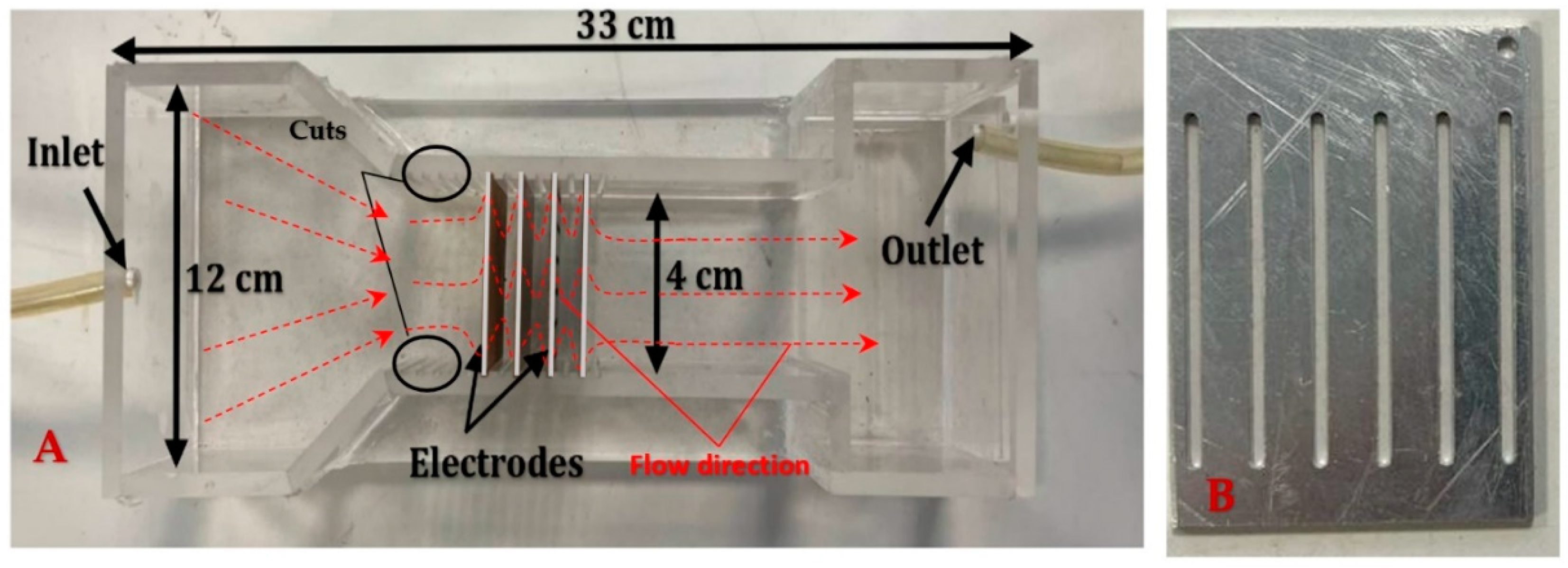
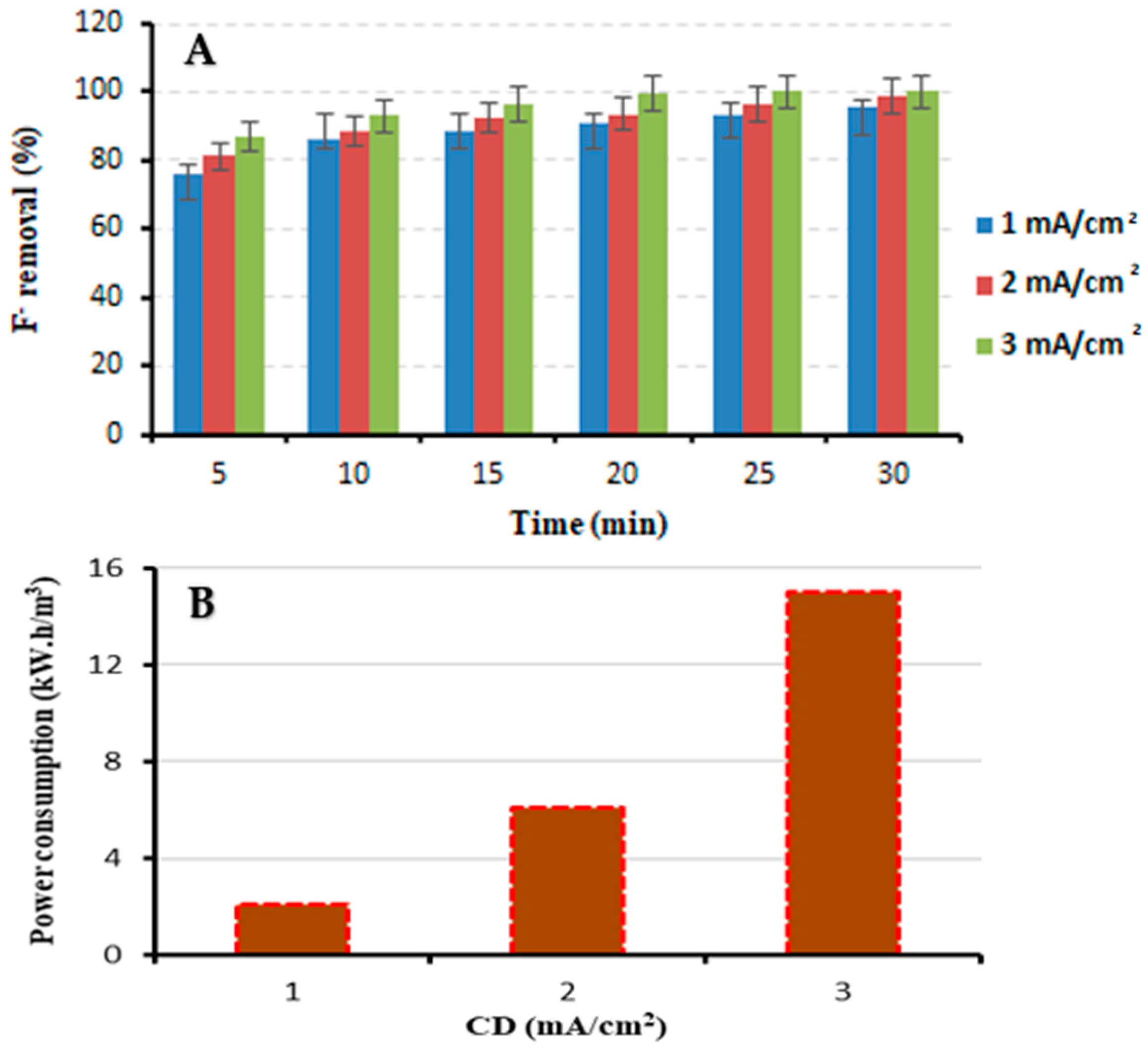
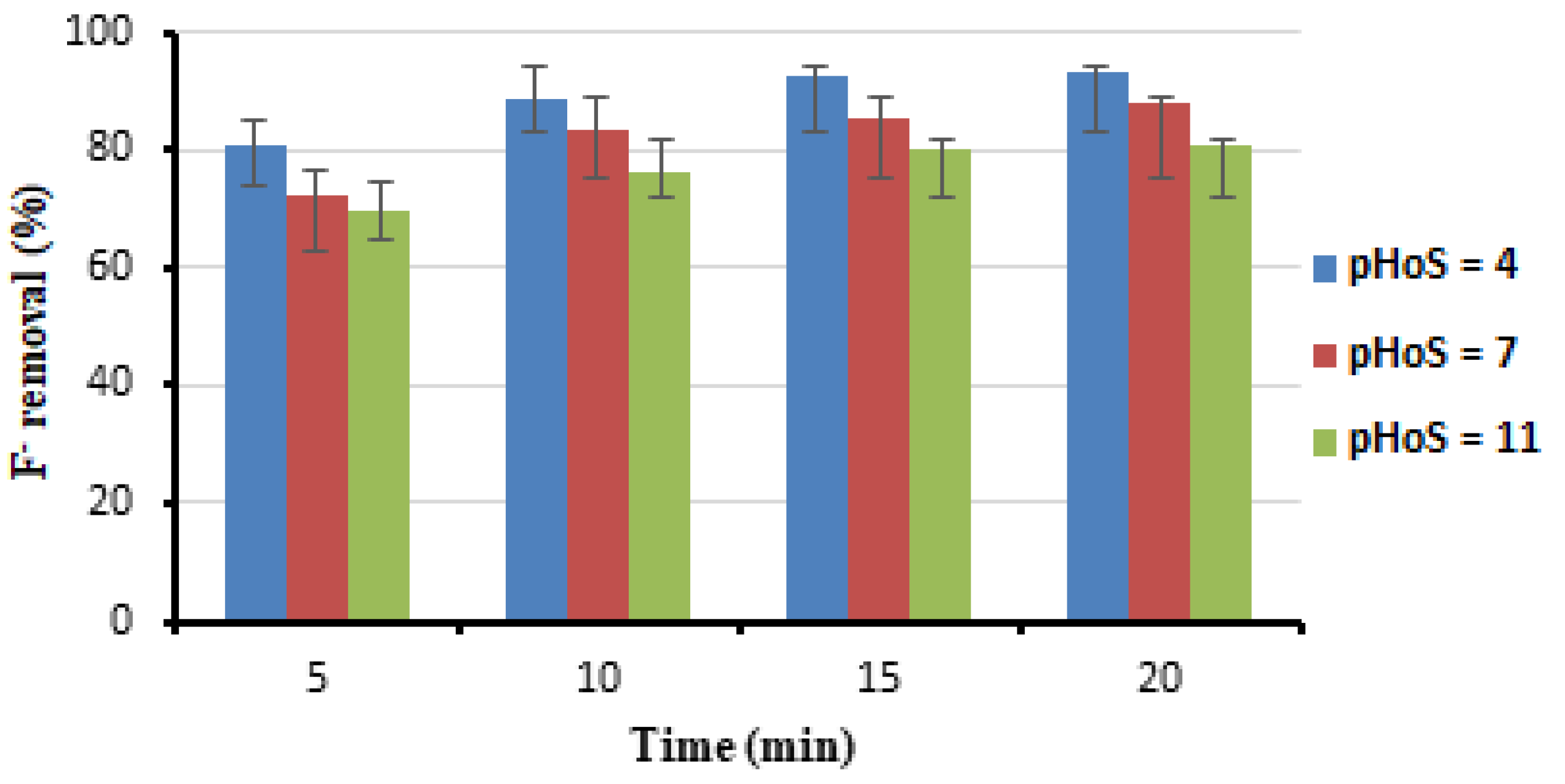
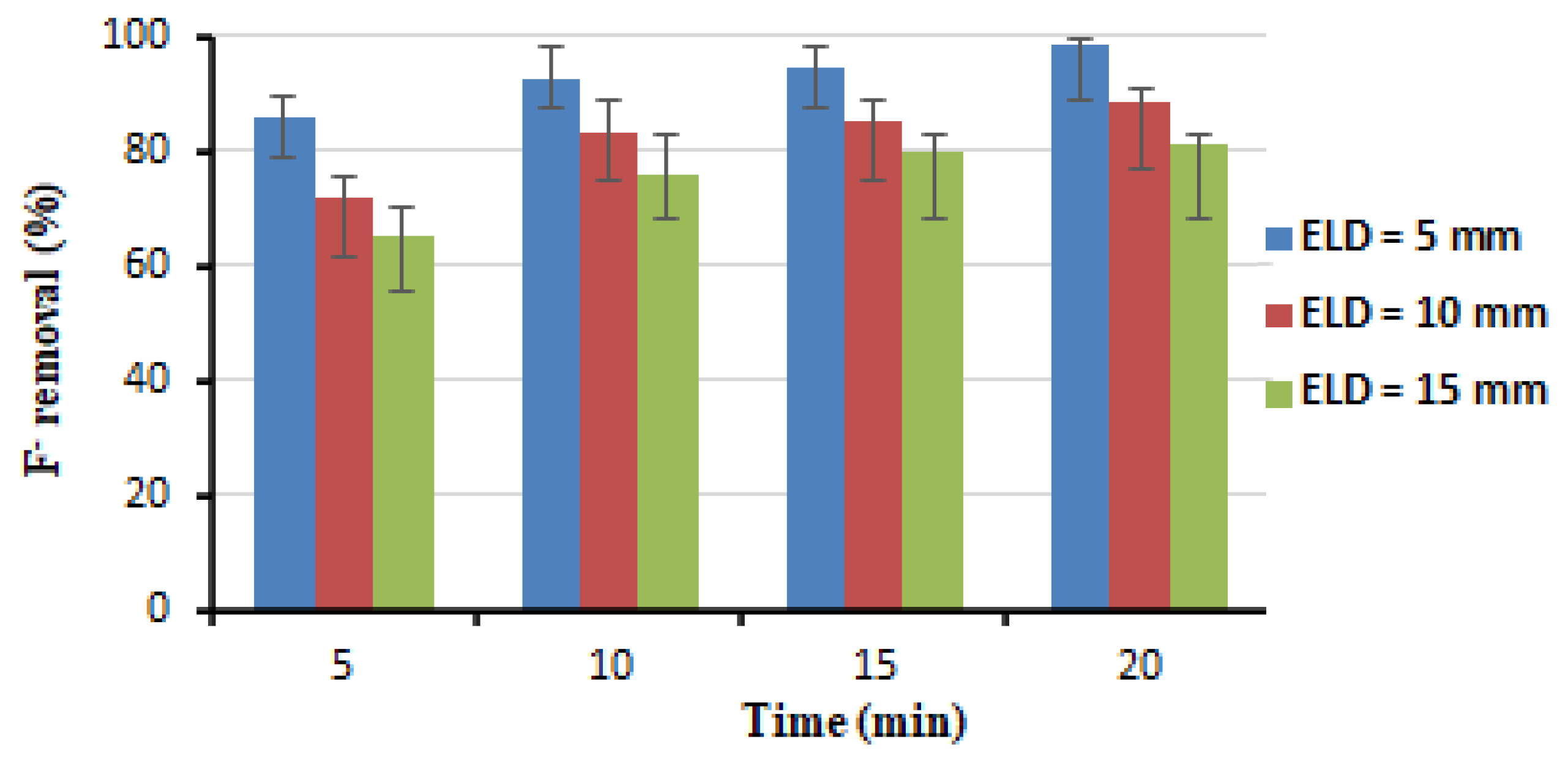
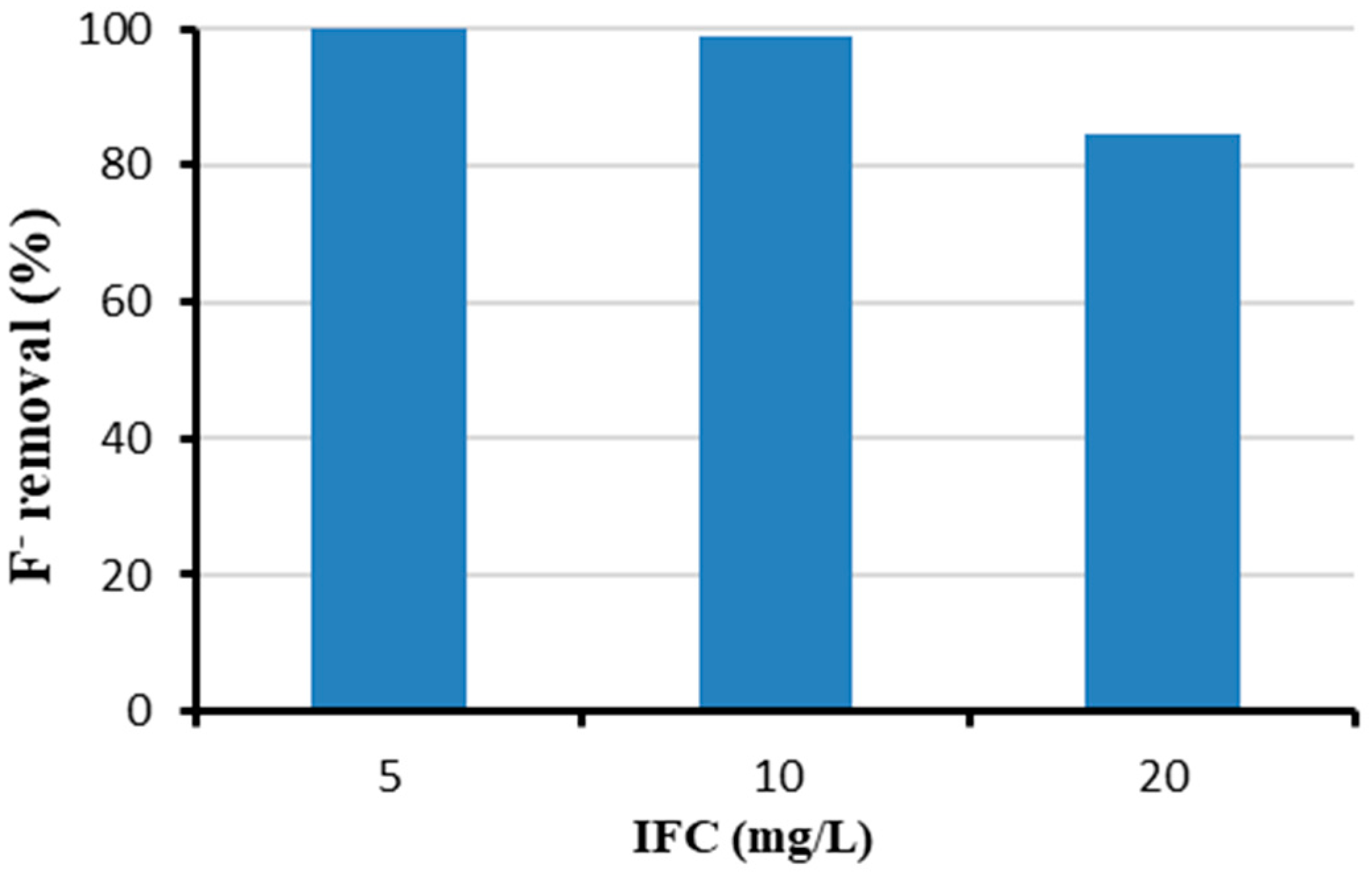
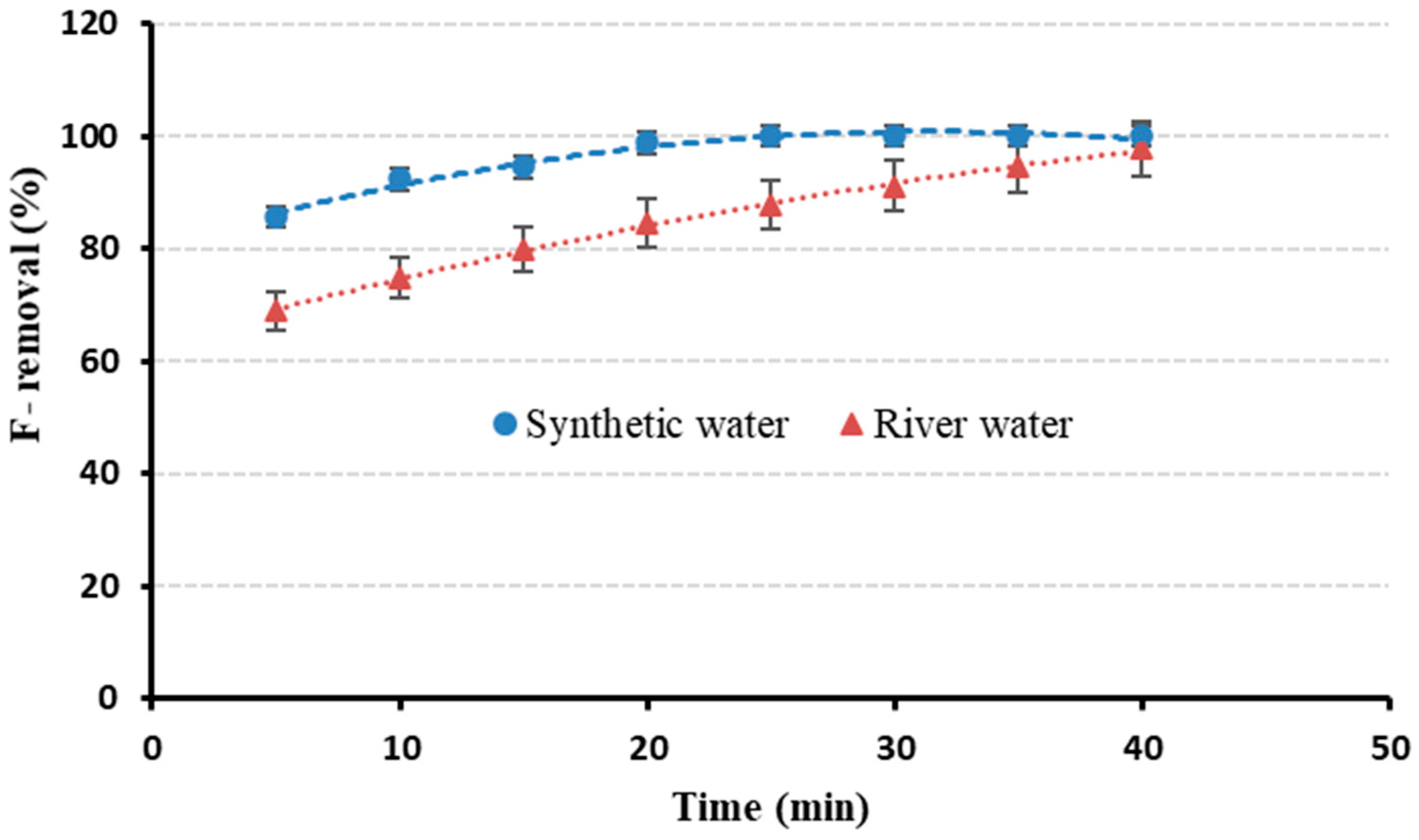
Publisher’s Note: MDPI stays neutral with regard to jurisdictional claims in published maps and institutional affiliations. |
© 2022 by the authors. Licensee MDPI, Basel, Switzerland. This article is an open access article distributed under the terms and conditions of the Creative Commons Attribution (CC BY) license (https://creativecommons.org/licenses/by/4.0/).
Share and Cite
Al-Samarrai, S.Y.; Karaghool, H.A.K.; Abdulridha, A.; Al-Ansari, N.; Salman, J.M.; Al-Sareji, O.J. Minimizing the Fluoride Load in Water Using the Electrocoagulation Method: An Experimental Approach. Environments 2022, 9, 38. https://doi.org/10.3390/environments9030038
Al-Samarrai SY, Karaghool HAK, Abdulridha A, Al-Ansari N, Salman JM, Al-Sareji OJ. Minimizing the Fluoride Load in Water Using the Electrocoagulation Method: An Experimental Approach. Environments. 2022; 9(3):38. https://doi.org/10.3390/environments9030038
Chicago/Turabian StyleAl-Samarrai, Shatha Y., Haneen A. Kh. Karaghool, Ali Abdulridha, Nadhir Al-Ansari, Jasim M. Salman, and Osamah J. Al-Sareji. 2022. "Minimizing the Fluoride Load in Water Using the Electrocoagulation Method: An Experimental Approach" Environments 9, no. 3: 38. https://doi.org/10.3390/environments9030038
APA StyleAl-Samarrai, S. Y., Karaghool, H. A. K., Abdulridha, A., Al-Ansari, N., Salman, J. M., & Al-Sareji, O. J. (2022). Minimizing the Fluoride Load in Water Using the Electrocoagulation Method: An Experimental Approach. Environments, 9(3), 38. https://doi.org/10.3390/environments9030038







